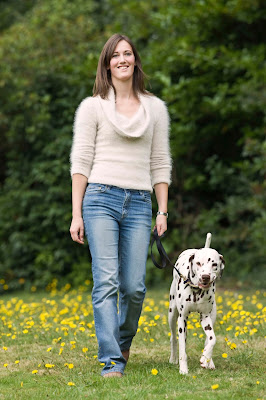Make sure you are the Boss when walking your dog
When you are out with your dog the leash and collar you choose is among the most important tools you have.
In many places - on the road, crossing farmland and in some parks - it's even required by law. There is a huge variety of collars to choose from, and the choice can be overwhelming. There are collars for training, for walking, and even for fashion. Which one is the best one for you and your dog? And what is the best way to use it when gaining control on your walks with the dog?
Simple leashes and collars

 These are for when there are no issues on your walk with the dog. A simple leash and collar enables you to keep your well-balanced dog safely at your side and out of harm's way. This is recommended for happy-go-lucky, easygoing dogs with no obedience problems.
These are for when there are no issues on your walk with the dog. A simple leash and collar enables you to keep your well-balanced dog safely at your side and out of harm's way. This is recommended for happy-go-lucky, easygoing dogs with no obedience problems.
It is important you remember to walk with your dog behind you or by your side to establish and reinforce your position as the leader in the pack
Slip collar
These collars are great tools when used correctly for correcting any misbehaviours your dog may have. When your dog is distracted by a squirrel, a bird, another dog, or maybe just a strong gust of wind, these collars allow for quick corrections to ensure your dog gets back on track.
All that is required is a firm but quick pull sideways on the leash. Pulling straight back will encourage your dog to pull against you. But a quick tug to the side you will knock the dog off balance and get his or her attention. It is essential to be aware of your dog's safety when giving corrections! If you are unfamiliar how to use the slip collar, talk to a dog walking professional.
Pack Leader Collars
Pack Leader Collars help keep a slip collar at the top of the neck - the neck's most sensitive area. A Pack Leader Collar is recommended for dogs who give trouble on walks, particularly with pulling.
By placing the collar on the neck's lower part, you actually help your dog pull you around. This works well with Alaskan sled dogs when they are pulling a load. With the harness at the shoulder around the neck base give the dogs the most control where their pulling power is concentrated. This is not what you want when you are taking your dog out for one of its daily walks! By putting the collar at the top of your dog's neck, your pet will be much more sensitive to your movements. This will encourage your dog to react to what you are communicating. Remember to keep your dog's head up to remove his nose from the many and varied distractions on the ground. This will ensure your dog's focus is on you so you can move forward together in harmony.
Harnesses
A harness can be a useful tool when you require your dog to pull you around, for example when you use roller blades or ride your bike.
Harnesses are also safe options for dogs who may have difficulty with certain collars, like slip collars. This includes dogs with restricted breathing because of their pushed-in faces - like pugs, mastiffs or bulldogs - or dogs with throat or trachea problems - like Pomeranians - and those dogs with slender, elongated necks - like Greyhounds, whippets, or Salukis.
Whatever collar you choose, it is fundamental that you pay attention to your body language and energy, because the leash and collar are together a method of communication that enables you - without a word - to instruct your dog what direction to go, how fast to walk, and when to stop.
It is important to stand tall with head up and shoulders back. By walking in this way you will reinforce that you are the pack leader and your energy will flow through the leash to the collar and your dog will understand who is the Boss.
Source:http://ezinearticles.com/?Dog-Collars-Are-Different:-Choose-Carefully&id=8957705






No comments:
Post a Comment